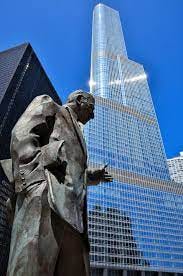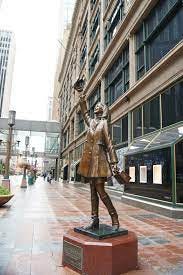To access other parts of this site, click here for the Home Page.
Believe it or not, Mike Royko had an identity crisis in 1972.
He wrote about it for his February 8 column in the Chicago Daily News:
“This occurs most often among young people. When it happens they sing a sad song about it, or renounce their parents’ central air conditioning, smoke strange things, put flowers in their hair, eat organically grown peanuts, or assume the lotus position.”
“As for myself, I never had an identity crisis. I have always known who I am, which, while deeply depressing, saved me a lot of running around looking for me. But now it has happened to me. I have had my identity crisis. It came about in a strange way.”
Here’s how it happened: Mike hoped to get picked from among the many reporters vying to go to China with President Nixon. For that, he needed a passport. For a passport, he needed a birth certificate. He didn’t remember ever seeing one. Mike goes to City Hall and gets his birth certificate at the clerk’s office.
“As I read it, my identity crisis exploded…it said my name was Mitchell.”
“How could my name have been Mitchell all of these years without my knowing it? And if it was Mitchell, why have I always thought it was Michael?...Then, who was I? Maybe Kup? I began feeling like a teen-ager.”
Who knows why Mike threw out Kup’s name. Irv “Kup” Kupcinet was the lead gossip columnist for the Chicago Sun-Times for 60 years. Mike Miner, long-time media critic for the Chicago Reader, mentioned to me recently that Kup’s was the only gossip column that people took seriously. Not that that means Mike took it seriously.
Younger readers won’t remember Kup at all, but he was a bona fide Chicago celebrity, because he ran with all the celebrities who came to town and had a local talk show. All the celebrities came to Chicago in those days, and when they did, they talked to Kup. Today, Kup has a statue on Wacker Driver near Wabash, across from the site of the old Sun-Times building, which is now Trump Tower.
I don’t begrudge Kup his statue. But I suddenly thought:
The campaign for a Mike Royko statue begins today.
My God. There’s a Mary Tyler Moore statue in Minneapolis, and we don’t have a statue for Mike Royko?
I immediately called Don Evans, executive director of the Chicago Literary Hall of Fame. The CLHOF is behind the wonderful sculpture of Gwendolyn Brooks by sculptor Margot McMahon, placed in Gwendolyn Brooks Park at 4532 S. Greenwood Ave. in 2018. CLHOF raised the money and spent untold hours getting the Chicago Park District to accept the sculpture. Believe me, you can’t just GIVE something nice to the Park District. You have to beg them to let you beautify a park and honor a titan of Chicago literature. Plus, CLHOF had to raise more than $50,000.
Don immediately agreed that Mike Royko should have a statue. He was inducted into the Chicago Literary Hall of Fame in 2011.
“If Charles Dickens took a piss in London, there’d be a plaque,” said Don. “When we put the statue of Gwendolyn Brooks into the park named for her, nobody knew who she was. I asked people—nobody there knew who she was, and the park is named for her. These things need to be contextualized. If you go to Dublin or Paris or London, they do a fantastic job honoring their great authors. So we would love to start [putting up more statues] with people inducted into the hall of fame.”
Now, Don made no promises. Even a single statue is a Herculean effort for the CLHOF board. But Don loved the general idea of honoring more Chicago literary giants here. It’s a lot of work, and a lot of money. Even if the CLHOF should decide to pursue it, there are others who also deserve the honor.
Therefore, I went to Change.org and created a petition to Mayor Lightfoot and the Chicago City Council, requesting a statue to Mike Royko. The city would never do it, and who would want to give them a project you’d like to see completed in your own lifetime? Bike flyover by Navy Pier ring a bell? But when you create a Change.org petition, you have to list someone you are petitioning. The city seemed like a good place to start.
If we can get enough signatures on a petition for Mike’s statue, it’s a first step to persuading somebody to provide a monument to the greatest Chicago newspaper columnist of the 20th century. It can’t hurt. It is free.
Here is the petition:
Chicago, the greatest city, deserves a statue of Mike Royko, its greatest columnist.
Mike Royko is the most iconic Chicago newspaper columnist of the 20th century. Like so many of us, Mike was the child of immigrants, and he never forgot it. It is unlikely anyone will surpass his ability to speak for the common Chicagoan.
Mike Royko invented Chicago's informal motto, "Ubi est mia," which translated from the Latin means, "Where's mine?" Mike won the Pulitzer Prize in 1972 for his biography of Mayor Richard J. Daley, "Boss."
"Boss" remains the definitive Chicago political book of that time period, never out of print.
Mike Royko, as we all know, began his column for the Chicago Daily News in 1963, shifting to the Sun-Times when the Daily News folded, and moving to the Chicago Tribune after Rupert Murdoch bought the Sun-Times. He wrote for the Tribune until his death in 1997.
Millions of Chicagoans woke up for over 30 years, every weekday, looking for Mike Royko's picture above his column. To see the phrase "Mike is on vacation" or "Mike is taking the day off" instead made their heart sink just a little.
We're not saying Mike Royko was perfect. No human being is perfect, and Mike was, above all, human. Frank Sinatra threatened to punch Mike in the nose. We believe that if perfection is the standard to which we hold anyone, including our heroes, we should all just throw in the towel right now.
Chicago has statues for Kup, Jack Brickhouse, Harry Carey, George Halas--but not Mike Royko. Minneapolis has a statue for Mary Tyler Moore, but Chicago can't honor its greatest columnist?
We believe Chicago can do what Minneapolis can do.
Actually SIGN HERE AT THIS LINK.
Do you dig spending some time in 1972? If you came to MIKE ROYKO 50 YEARS AGO TODAY from social media, you may not know it’s part of the book being serialized here, one chapter per month: “Roseland, Chicago: 1972.” It’s the story of Steve Bertolucci, 10-year-old Roselander in 1972, and what becomes of him. Check it out here.
To get the weekly compilation of MIKE ROYKO 50 YEARS AGO TODAY in your mailbox along with THIS CRAZY DAY IN 1972 and new chapters of the book, SUBSCRIBE FOR FREE!











Nice!